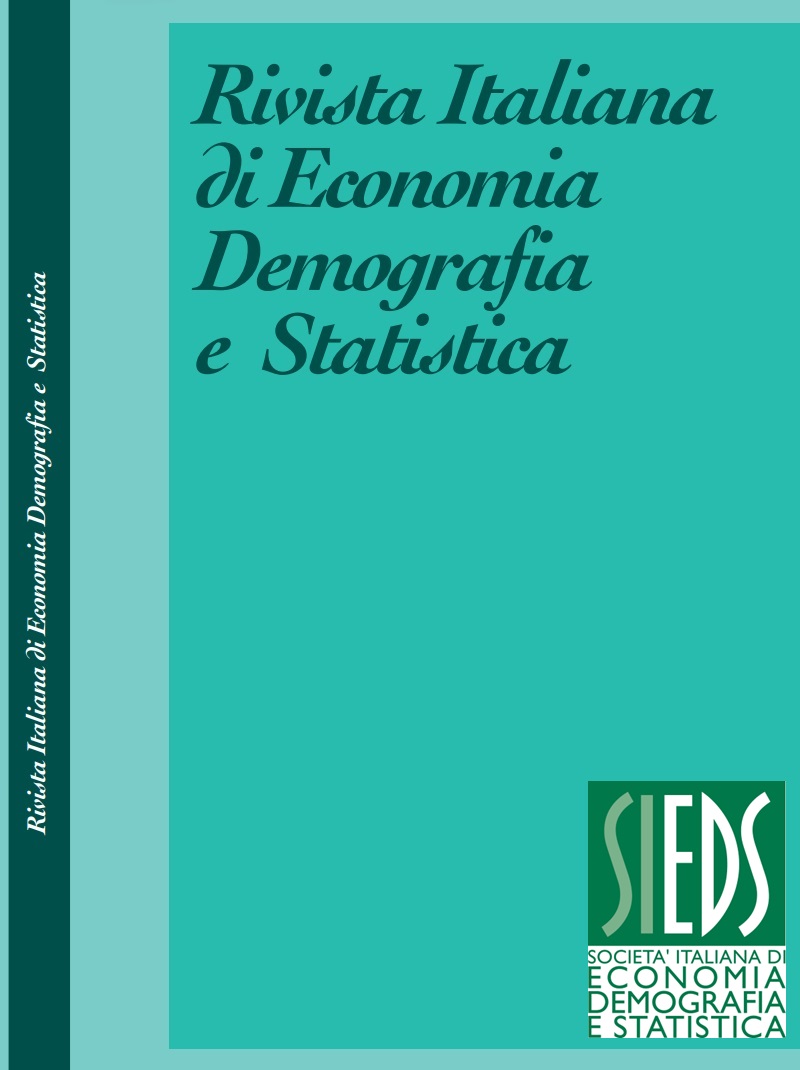Analyzing health inequalities in Italian metropolitan cities: a multidimensional approach
DOI:
https://doi.org/10.71014/sieds.v79i1.367Keywords:
Health Inequalities, Metropolitan Cities, Preventable and Treatable Mortality, Hospitalization, Major Causes of MortalityAbstract
This study aims to verify whether, as with other previously investigated demographic and socio-economic phenomena (Cangialosi et al., 2023; Istat, 2023), in Italian metropolitan cities, the relationships between the capital city and other surrounding territorial aggregates, divided based on geographical proximity, can explain health inequalities among the population. Health, defined as a state of complete physical, mental, and social well-being (WHO, 1948), is influenced by various determinants, including individual, social, economic, and environmental factors. It is plausible to hypothesize the existence of a territorial health gradient among municipalities with high availability of health infrastructures, low out-of-region hospital mobility, and favorable socio-economic conditions, compared to those with less accessibility to such services and less advantageous socio-economic conditions. Capitals (and sometimes municipalities in the first urban belt) often exhibit these advantageous conditions and play a central role in the organization of the territory (Logan et al., 2002). Furthermore, the geographical positioning of territories is a significant factor in the proposed analysis, traditionally highlighting an increasing North-South discrepancy (Istat, 2024). A cluster analysis carried out on representative indicators of health conditions, health supply and economic situation facilitated the identification of homogeneous territorial groups and the description of their characteristics.
References
BARTON H., GRANT M. 2006. A health map for the local human habitat. Journal of the Royal Society for the Promotion of Health, Vol. 126, No. 6, pp. 252-253. DOI: https://doi.org/10.1177/1466424006070466
BRAVEMAN, P., GOTTLIEB L., 2014. Defining equity in health. Journal of Epidemiology and Community Health, Vol. 58, No. 3, pp. 254-258. doi:10.1136/jech-2014-204288 DOI: https://doi.org/10.1136/jech.57.4.254
CANGIALOSI D., TRONU D., VACCA D. 2023. The ageing of the population in urban contexts: a study on Italian metropolitan cities. Rivista Italiana di Economia Demografia e Statistica, Vol. 77, No. 3, pp. 22-32, July-Sept.
COMMISSION ON SOCIAL DETERMINANTS OF HEALTH. 2008. Closing the gap in a generation: health equity through action on the social determinants of health. Final report of the Commission on Social Determinants of Health. Geneva: World Health Organization.
DAHLGREN, G., WHITEHEAD, M. 1991. Policies and strategies to promote social equity in health. Stockholm: Institute for Futures Studies.
DIEZ ROUX, A. V., & MAIR, C. 2010. Neighborhoods and health. Annals of the New York Academy of Sciences, Vol. 1186, No. 1, pp. 125-145. doi:10.1111/j.1749-6632.2009.05333.x DOI: https://doi.org/10.1111/j.1749-6632.2009.05333.x
ENGEL, G.L. 1977. The need for a new medical model: a challenge for biomedicine. Science, Vol. 196, No. 4286, pp. 129-136. doi:10.1126/science.847460 DOI: https://doi.org/10.1126/science.847460
ISTAT. 2024. Condizioni di salute e offerta sanitaria nelle città metropolitane. Statistica Focus, May 21 2024
ISTAT. 2023. Gli anziani nelle città metropolitane. Profilo sociodemografico e analisi comparativa fra i contesti urbani. Statistica Focus, August 03 2023
ISTAT. 2022. Attività antropiche e salute delle coste. Indicatori di rischio e sostenibilità per aree costiere e insulari in Italia e nell’Unione Europea. Roma: Istituto nazionale di statistica. ISBN 978-88-458-2084-7
ISTAT. 2020. Rapporto sul territorio 2020. Collana: Letture statistiche. Roma: Istituto nazionale di statistica. ISBN 978-88-458-2014-4; doi.org/10.1481/Istat.Rapportoterritorio.2020
ISTAT. 2019. La salute nelle regioni italiane. Bilancio di un decennio. Roma: Istituto nazionale di statistica. ISBN 978-88-458-1970-4
KAWACHI, I., BERKMAN, L. F. 2003. Neighborhoods and health. Oxford University Press. ISBN 978-0-19-513838-2
LOGAN, J.R., ALBA, R.D., ZHANG, W. 2002. Immigrant enclaves and ethnic communities in New York and Los Angeles. American Sociological Review, Vol. 67, No. 2, pp. 299-322. http://dx.doi.org/10.2307/3088897 DOI: https://doi.org/10.1177/000312240206700207
MACQUEEN, J. 1967. Some methods for classification and analysis of multivariate observations, in: Le Cam, L. and Neyman, J. Proceedings 5th Berkeley Symposium on Mathematical Statistics and Probability. Vol. 5.1, pp. 281-297. University of California Press, Berkeley
MARMOT, M., WILKINSON, R.G. 2006. Social determinants of health. Oxford: Oxford University Press. ISBN 978-0-19-856589-5
MURRAY, C.J., LOPEZ, A.D. 1996. The Global Burden of Disease: A Comprehensive Assessment of Mortality and Disability from Diseases, Injuries, and Risk Factors in 1990 and Projected to 2020. Cambridge, MA: Harvard School of Public Health on behalf of the World Health Organization and the World Bank. ISBN 978-0-674-3544
ROUSSEEUW, P. J. 1987. Silhouettes: a graphical aid to the interpretation and validation of cluster analysis. Journal of Computational and Applied Mathematics. Vol. 20, pp.53-65. DOI: https://doi.org/10.1016/0377-0427(87)90125-7
ROTHWELL, J.T., OLFERT, M.R., PARTRIDGE, M.D. 2015. Settled to core: Metropolitan nonmetropolitan disparities in human capital, amenity, and knowledge spillovers. Regional Studies, Vol. 49, No. 2, pp. 270-287.
VLAHOV, D., FREUDENBERG, N., PROIETTI, F., OZONO, S., COOKSON, S., CONNOLLY, M., GALEA, S. 2007. Urban as a determinant of health. Journal of Urban Health, Vol. 84, No. 1, pp. 16-26. Doi 10.1007/s11524-007-9169-4 DOI: https://doi.org/10.1007/s11524-007-9169-3
WILLIAMS, A., LARRIER, D., ALTMEYER, W. 2018. A survey of clustering algorithms for big data: Taxonomy and empirical analysis. IEEE Transactions on Knowledge and Data Engineering, Vol. 30, No. 8, pp. 1470-1484.
WORLD HEALTH ORGANIZATION (WHO). 1948. Constitution of the World Health Organization. Geneva: World Health Organization.
WORLD HEALTH ORGANIZATION (WHO). 2016. Urbanization and health. Geneva: World Health Organization.
Downloads
Published
Issue
Section
License
Copyright (c) 2025 Daniela Vacca, Lucia Martina, Debora Tronu

This work is licensed under a Creative Commons Attribution 4.0 International License.



